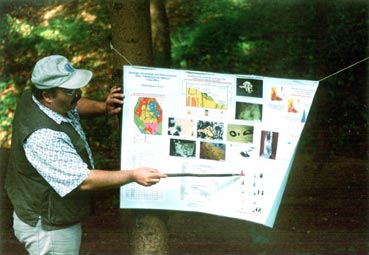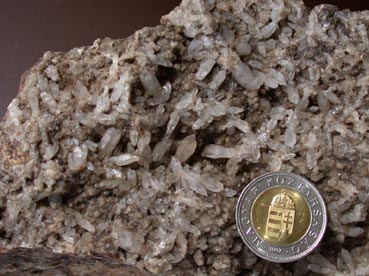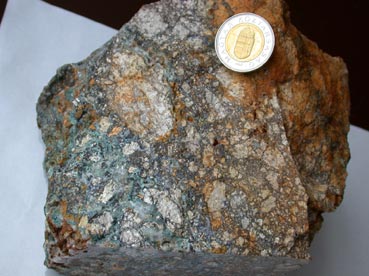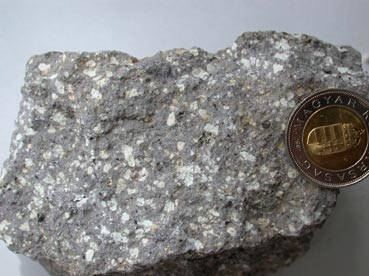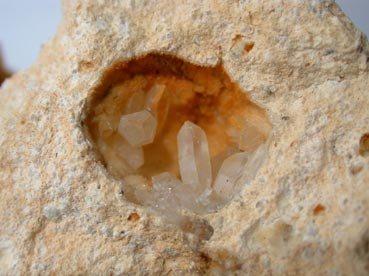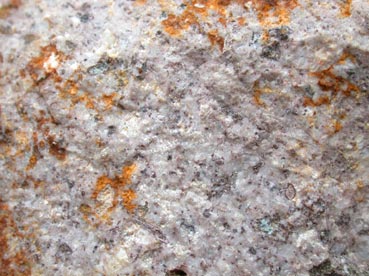| Tokaj Mountains Field Trip 2002: |
|
||
|
DAY-2. Au-Ag vein deposits of Telkibánya
Introduction to geology and the Au-Ag deposit at Telkibánya At Telkibánya, volcanic and sedimentary rocks of Badenian age occur below a 790 m thick andesitic volcanic sequence of Sarmatian age in the Telkibánya-2 (Th-2) drillhole (Figs. 1., 2 and 15). In the Hidasnémeti-1 (Hi-1) drillhole, to the west, as well as in the Füzérkajata-2 (Fk-2) drillhole to the east of Telkibánya, the volcanic-sedimentary sequence is considerably different by comparison with the mineralized area (Fig. 2). According to the results of these drillings, the accumulation of thick sedimentary deposits indicates the beginning of the formation of the graben structure in Lower Badenian time. The macro- and microfossils from the argillic sediments suggest a shallow marine environment (Széky-Fux, 1970). In the upper part of this sedimentary sequence intercalations of acidic volcanic tuffs as well as dacitic rocks occur. Biotite from the thick rhyolitic tuff at the bottom of the Hi- 1 borehole gives K/Ar ages of 13.0-15.2 Ma (Pecskay et at., 1986). The submarine dacitic-andesitic lavas, and hyaloclastite breccias, dacite domes, tuff of dacitic-rhyotitic composition interbedded with shallow marine sediments in drillhole Fk-2, indicate subsidence of the volcano-tectonic graben contemporaneously with volcanic activity. In contrast, the Telkibánya-2 drillhole encountered only a thin (30 m) Badenian sedimentary sequence. The Sarmatian volcanism in the Telkibánya area started by deposition of rhyolitic tuffs overlain by and partly intercalated with shallow marine and fluvioclastic sedimentary rocks. The eruption center of the rhyolite tuff is located in the southwestern part of this area (Horváth et al., 1989; Fig. 15). The tuff is covered by 30-40 m thick sandstone-conglomerate fluvioclastic sequence in the eastern part of the deposit (Figs. 15 and 16). The conglomerate consists of well rounded pebbles of metamorphic rocks, as large as 10 cm. Andesite, dacite and rhyolite were subsequently emplaced as lavas, domes and dikes. These are the main rocks that crop out in the mineralized area (Fig. 15). Based on evaluation of satellite images, remnants of two andesite calderas 5-7 kin in diameter and andesite cones were recognized NNE of Telkibánya (Horváth et at., 1989; Horváth and Zelenka, 1997; Fig. 15). The Th-2 drillhole revealed that the southern caldera, which hosts the majority of mineralization, contains an approximately 700 in thick sequence of andesite lavas. K/Ar ages for the fresh andesite are between 11.8±1.0 and 13.1±1.2 Ma. Within the calderas, rhyolite domes and lava flows, as well as rhyodacite flows were also emplaced. Some of these acidic rocks are intensely altered. A subvolcanic body corresponding to the intrusive facies of the lower andesite unit was emplaced in the central part of the southern caldera. Intrusive breccias were found along its contacts with both Upper Bademan clays and Sarmatian clays and rhyolite tuff (Horváth and Zelenka, 1997). The area of positive gravity anomalies coincides with the location of this andesitic body (Fig. 15). Subsequently faults with NNW-SSE, NE-SW and E-W strikes developed.
The latest stage of volcanic activity in the region is represented by unaltered upper pyroxene andesite lava flows covering the higher elevations south of Telkibánya (Gyarmati, 1977). The K/Ar age of this rock is 10.7 Ma (Pécskay et al., 1986). The 0.5 to 10 in thick unaltered pyroxene andesite dikes occurring in the strongly mineralized southern caldera (Fig. 15) have K/Ar ages between 10.6±1.4 and 10.9±0.5 Ma (Table 4., samples 360 and 641), suggesting that the emplacement of these late dikes was genetically related to the volcanism producing the upper andesitic lava flows.
Wall rock alteration In the Telkibánya area, precious- and base-metal mineralization formed in association with both the Badenian and the Sarmatian volcanic stages. The older phase was recognized onily in the Th-2 borehole at depths between 900 and 1050 m (Fig. 2). There, stockwork ineralization occurs in mm-cm thick veinlets hosted by the Badenian volcanic rocks, and it is characterized by a sphalerite-galena-pyrite-chalcopyrite -arsenopyrite assemblage (Széky-Fux, 1970; Molnár, 1993; Horváth and Zelenka; 1997). The host rocks underwent various alteration processes from the a1bite-chlrite-epidote-catbonate bearing propilitization to adularia-sericite alteration. The near-surface mineralization is hosted by the Sarmatian volcanic rocks. The deposit is located mostly in the southern caldera structure, where the major host rock is the strongly altered subvolcanic andesite (Fig. 15). In the vicinity of veins, especially in the near-surface zones, the altered andesite contain 8-14 wt% K20 (Széky-Fux, 1970). The high potassium content of the rock resulted from the replacement of plagioclase by K-feldspar, and the occurrence of adularia in the dense network of thin (0.1-1 mm) veinlets, as well as in the silicified groundmass (Molnár, 1993; Molnár, 1994b). Hydrothermal K-feldspar that replaces plagioclase was subsequently altered to illite while adularia in veinlets is fresh. This suggests that replacement of plagioclase by K-feldspar and its successive alteration proceeded the fracturing of the host rock and precipitation of adularia in the veinlets. The mafic phenocrysts of the strongly altered rock are replaced by quartz aggregates and chlorite. Pervasive dissemination of pyrite crystals with sizes of 0.1-1mm is also common. According to Szeky-Fux (1970), the adularia-sericite alteration is funnel-shaped and pinches out in the deeper zones of the mineralization (Fig. 16). Propylitic alteration envelope the adularia bearing zones and this type of alteration predominates along the deeper zones of veins. Plagioclase is altered to albite or calcite, and mafic minerals are replaced by chlorite. Disseminated pyrite is common, and in the deeper parts of the propylitic zone, epidote is present. In comparison to the fresh andesite and propylite, the Na20, CaO, MgO and FeO content is very low, whereas the Fe203 content has increased to 4-7 wt.% in the alteration zones with adularia. The K-rich rocks are also enriched with respect to As, Zn and Ni (100-130 ppm) as well as Ba (up to 0.08 wt.%; chemical data are from SzékyFux, 1970). Rhyolitic tuff in the eastern part of the deposit (Figs 15 and 16) contains strongly altered zones characterized by the complete dissolution of pumiceous fragments. Within these vugs euhedral (platy and rhombohedral) alunite crystals up to 1 cm are present (Molnár, 1993). Alunite also occurs as disseminations in the porous groundmass of the rock as well as in comb-textured aggregates filling fractures. The groundmass of the rock shows silicification in the form of fine-grained quartz aggregates and weak dissemination of xenomorphic pyrite with a small amount of kaolinite. Characteristics of the veins The majority of vertical-subvertical veins at Telkibanya trend north subparallel to major faults of the area; a few trend NE (Fig. 15). The E-W trending faults cross cut mineralized veins. (Széky-Fux, 1970). The major veins extend to 3 km strike length and their width varies from 0.1 to 1 meter. Hydrothermal and tectonic breccia zones (3-5 m width) commonly occur along the contacts of the veins (Fig. 17). In the upper zones of the deposit the hydrothermal breccias are strongly silicified and have very fme-grained rock-flour matrix with disseminated pyrite. The matrix of the breccia veins is less silicified and forms a softer, argillised mass in the deeper zones. Wall rock fragments in the breccias are semiangular-round with variable size, up to 5 cm. Angular fragments of the silicified fme-grained matrix are also present suggesting repeated brecciation. The hydrothermal breccias grade into fractured country rock that have undergone adularia-sericite alteration. In the vein outcrops, quartz and lesser amounts of chalcedony, opal, kaolinite and smectite are common. Five major textural varieties of vein quartz can be distinguished (Molnár, 1993; Fig. 18). At some places (Fig. 16) quartz pseudomorphs after bladed calcite also occur. Euhedral quartz crystals are widespread in the 1-10 cm size gas cavities of altered rhyolite, and in vugs of brecciated zones in altered andesite and rhyodacite. This type of quartz shows perfect euhedral-prismatic and scepter habit. Opal (opal A and opal CT; Molnár and Szakáll, 1994) and chalcedony predominate in the northern termination of veins. Coarse aggregates of rhombohedral and scalenohedral calcite occur in the deeper zones of the veins where it is associated with quartz and sulfides (Fig. 16). Calcite is also common in stockwork mineralization found in the Th-2 drillhole (see location on Fig. 15) between 430 to 500 m depth below the surface (Horváth and Zelenka, 1994).
The
sulfide paragenesis is simple. With the exception of pyrite, base-metal
sulfides appear in small pockets in the deeper parts (below 450 m elevation)
of the veins. In this base-metal rich ore, chalcopyrite, galena, freibergite
and acanthite are partially replaced by a later sphalerite-pyrite association,
which is followed by the precipitation of a second generation of acanthite,
Ag-bearing sulfosalts and pyrite. This late kg-rich paragenesis also
contains 5-10 jim large grains of native gold. A late stage “gel-like”
pyrite often overgrows the earlier pyrite and this late Fe-sulfide contains
up to 3-4 wt% arsenic plus antimony (Molnár, 1993). Sphalerite is always
characterised by growth zonation with alternating thick yellow and dark
brown zones. Bulk chemical analyses (Széky-Fux, 1970) and XRD analyses
(Molnár, 1993) indicate that the sphalerite contains 3.3 to 7.8 wt0/o
Fe. Base-metal content is very low in the upper zones of veins. Pyrite
is the major sulfide mineral with very irregular distribution in the
siliceous and hydrothermal breccia veins. Native gold occurs sporadically
as fine disseminations in quartz. The silver content of gold grains
is higly variable up to 45 wt0/o (Szakáll and Kovács, 1994).
Enrichment of gold and silver (Au up to 7 ppm; Ag up to 320 ppm) occur
in 10-15 m wide chimney-like structures in the pyrite-rich zones of
the quartz veins (Horváth and Zelenka, 1997). Base-metal rich pockets
of the deeper zones have Au concentrations up to 20 ppm and silver concentrations
up to 600 ppm (Széky-Fux, 1970). Siliceous hydrothermal breccia veins
contain 100-750 ppm Ag; the Au-content is usually below I ppm. Breccias
with argillic (smectite, illite) matrix and the clay rich selvages along
them contain 0.4-6.4 ppm Au and 10-630 ppm Ag. The quartz and quartz-carbonate
stockwork (Th-2 drillhole, 430-450 m; Veresviz valley, Fig. 16) contain
0.6-2.0 ppm Au and 1-14.8 ppm Ag (Horváth and Zelenka, 1994). The most
typical secondary minerals in the oxidation zone (above 380 m elevation)
are limonite, goethite, Mn-oxides, jarosite-plumbojarosite, gypsum,
anglesite, melanterite, halotrichite and ahmogen (Széky-Fux, 1970; Szakáll
et al., 1994a; Molnár and Szakáll, 1994). Chlorargyrite, Ag-Hg-chloride
and Pb-chloride are also reported (Szakáll et al., 1994). The K/Ar ages of adularia lie in a narrow time interval between 12.2+0.7 and 12.4+0.5 Ma. The data from intensively altered rock samples with very high K content show slightly younger ages from 12.0+0.5 to 12.4+0.8 Ma, but considering the standard deviation of the K/Ar data they are indistinguishable from the ages determined on hydrothermal minerals. Data for alunites are 12.49+0.51 and 12.27+0.57 Ma indicating that alunite alteration is coeval with hydrothermal mineralization at Telkibanya.
Fluid inclusion data Homogenization temperatures for sphalerite, adularia and calcite range from 200 to 2700C with most typical values between 230 and 2600C. Data for vein filling quartz are polymodally distributed between 130 and 2700C. Homogenization temperatures correlate with the texture of vein filling quartz. In contrast, frequency distribution of homogenization temperatures from euhedral quartz in vugs of host rocks shows a well-defined peak at 230 0C. Coexisting liquid-rich and vapor-rich fluid inclusions occur in vein quartz samples with homogenization temperatures above 2000C as well as in euhedral quartz crystals. This suggests that boiling conditions existed during the hydrothermal activity (Molnár and Zelenka, 1995). The ice melting temperatures correspond to salinities less than 5 NaCl equiv. W%. The variation of ice melting temperature with the homogenization temperature suggests that both boiling with gass loss and dilution with marginal steam heated waters affected hydrothermal fluids during mineralization. Locally dilution with ground water also occurred. The degassing of fluids during boiling is also indicated by the characteristics of the adularia-sericite alteration in the Telkibánya ore deposit. The precipitation of adularia after sericitic alteration of earlier K-feldspar indicates an increase of pH during stockwork-type fracturing of the altered host rock (Molnár, 1994). This shift of pH to neutral-alkaline conditions can be explained by the partitioning of acidic gases, such as C02, into the vapor phase during boiling related to a pressure drop resulting from the development of open fractures (Browne and Ellis, 1970). The precipitation of calcite in the same temperature range as adularia (Fig. 19) and the occurrence of bladed calcite (pseudomorphosed by quartz) in some veins (Fig. 16) is also consistent with the occurrence of boiling (Brown and Ellis, 1970; Simmons and Christiensen, 1994). Field stops in Telkibánya ore field
STOP-1: King Mátyás well
STOP-2: Jó Hill, top The
top of Jó Hill is a narrow relatively flat area resembling a small plateau
with very steep marginal slopes. The actual morphology suggest that
the plateau is an intensively silicifized zone following a vein. Specimens
can be collected from the steep slopes from fallen chunks of rocks.
Hydrothermal minerals include overgrown prismatic and comb quartz in
fractures and cavities developed in fractured and altered rhyolite tuff.
Hydrothermal breccias are also common. The size of fragments and shorting
vary greatly. The cement is mostly chalcedony or quartz. Well sorted
breccia specimen suggest transport of clasts along breccia dikes. Fluid
inclusion petrography indicates boiling of fluids that corresponds to
the fracturing and consequent pressure loss. Traces of ancient shallow
depth open pit mining are rarely seen along the top of Jó Hill.
STOP-3: Veresvizi medieval muck pile field The valley is filled with hundreds of rock debris piles and mucks giving rise the hummocky relief of the surface. Medieval remnants of ore processing building complex is still on site that was a main collective center of the nearby oncve producing adits. Precious metal production from the Telkibánya mine is not known due to the lack of documentation from the Medieval Ages. Dumps near the medieval mills contain 29 546 tons of fie-grained mud with 0.1 to 0.7 ppm Au and 3-168 ppm Ag (Horváth and Zelenka, 1997). These data suggest that the medieval miners used efficient crushing and washing methods for processing of ores, leaving largely uneconomic waste material.
STOP-4: Fehér hill, southwestern hillside The lower level of Fehér hill is composed of andesite. Andesite generraly shows propillitic alteration farther fom the veins. Alteration pattern changes to adularia-sericit alteration closest to the veins. At this location in the rouadcuts andesite exhibiting propillitic alteration crops out rarely.
STOP-4: Fehér hill, central western hillside, large land slide The top of Fehér hill composes of extrusive fluidal rhyolite with aligned gas cavities often exceeding the size of 3-4 cm. Close to the hydrothermal vein running through the backbone of Fehér hill rhyolite displays alteration. The cavities are filled with minerals precipitated from hydrothermal fluids. These include splendid crystals of prismatic quartz overgrown on a microcrystalline crust of quartz. Tabular brown-yellow zoned barite rarely appears in the cavities associated with quartz.
STOP-5: Kánya hill, eastern slope The rhyodacite and rhyolite in the eastern part of the mineralization (Good Luck vein) is characterized by intense potassic alteration and silicification. K-feldspar replaces phenocrysts and groundmass. Mafic minerals are replaced by chlorite. Argillic alteration with illite, carbonate alteration, and pyrite dissemination is also typical (Kozák, 1994).
STOP-6: Kánya hill, eastern slope conglomerate The Sarmatian rhyolitic tuffs overlain by and partly intercalated with shallow marine and fluvioclastic sedimentary rocks is covered by 30-40 m thick sandstone-conglomerate fluvioclastic sequence in the eastern part of the deposit (Figs. 15 and 16). The conglomerate consists of well rounded pebbles of metamorphic rocks, as large as 10 cm. The conglomerate overlying the rhyolitic tuff in the eastern part of the mineralization (Figs. 15 and 16) shows intense silicification. Kozák (1994) reported the occurrence of adularia in the fractures of this rock. STOP-7: Kánya hill, top, Jószerencsét (Good Luck) vein, Lobkowitz vein The near-surface mineralization is hosted by the Sarmatian strongly altered subvolcanic andesite. In the vicinity of veins, especially in the near-surface zones, the altered andesite contain 8-14 wt% K20 (Széky-Fux, 1970). The high potassium content of the rock resulted from the replacement of plagioclase by K-feldspar, and the occurrence of adularia in the dense network of thin (0.1-1 mm) veinlets, as well as in the silicified groundmass (Molnár, 1993; Molnár, 1994b).
Hydrothermal K-feldspar that replaces plagioclase was subsequently altered to illite while adularia in veinlets is fresh. This suggests that replacement of plagioclase by K-feldspar and its successive alteration proceeded the fracturing of the host rock and precipitation of adularia in the veinlets. The mafic phenocrysts of the strongly altered rock are replaced by quartz aggregates and chlorite. Pervasive dissemination of pyrite crystals with sizes of 0.1-1mm is also common. According to Szeky-Fux (1970), the adularia-sericite alteration is funnel-shaped and pinches out in the deeper zones of the mineralization. Propylitic alteration envelope the adularia bearing zones and this type of alteration predominates along the deeper zones of veins. Plagioclase is altered to albite or calcite, and mafic minerals are replaced by chlorite. Disseminated pyrite is common, and in the deeper parts of the propylitic zone, epidote is present.
|
|||


